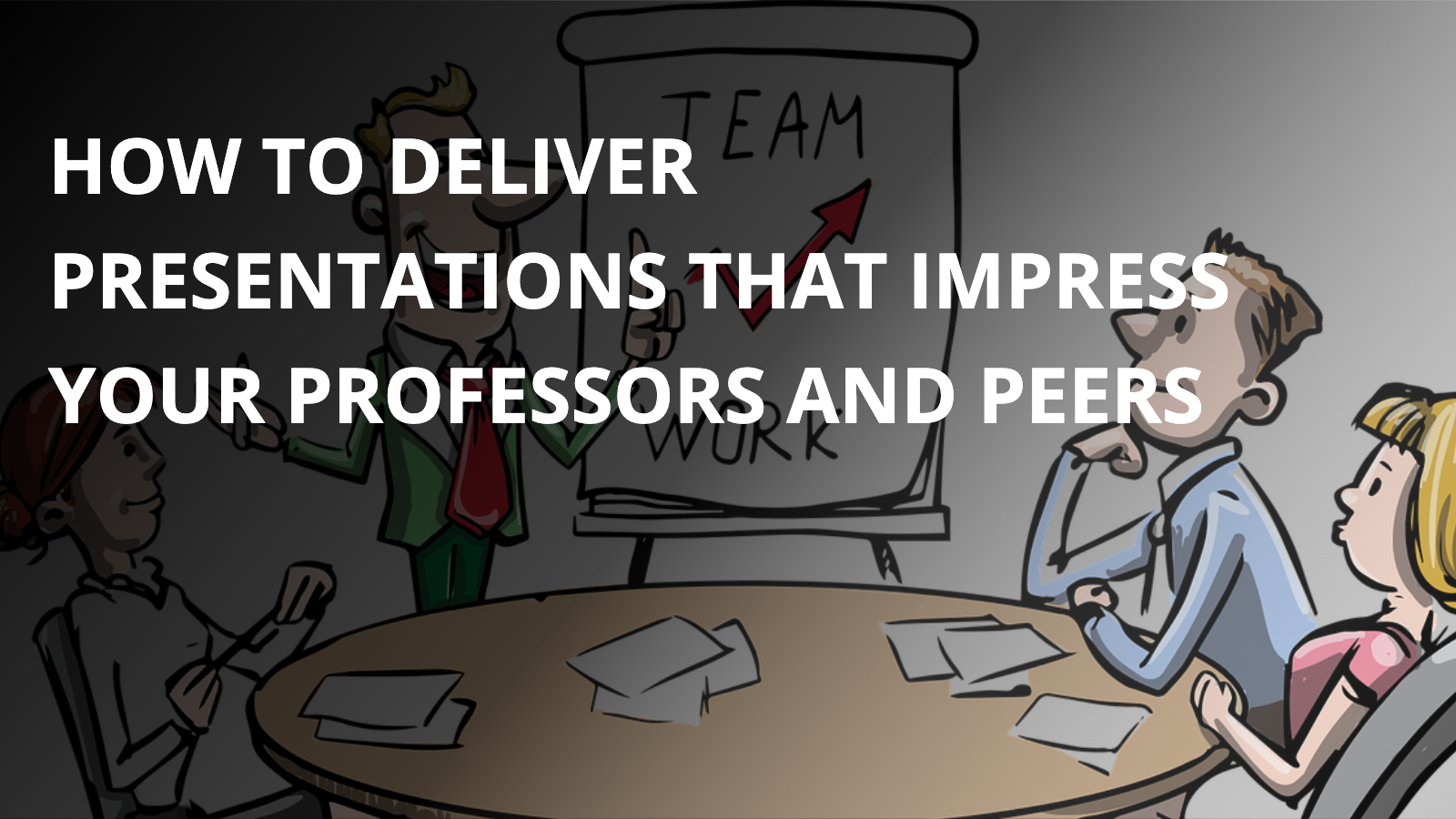How to Deliver Presentations that Impress Your Professors and Peers
 Ritik Makhija
Ritik Makhija
Tips to deliver presentations that will impress your professors and peers:
Make the first 30 seconds count: The first 30 seconds of your presentation are crucial. Use this time to grab your audience’s attention and set the tone for the rest of your presentation.
Compare and contrast: Compare and contrast your solution with the status quo. This will help your audience understand why your solution is better than what’s currently available.
Use visual aids: Use visual aids to summarize and clarify your big ideas. This will help your audience understand complex concepts more easily.
Get your audience involved: Get your audience involved to build trust and rapport. Ask questions, encourage participation, and make them feel like they’re part of the presentation.
Use a clean, consistent presentation layout and design: A clean, consistent layout and design will help keep your audience focused on your message.
Eliminate extraneous detail: Eliminate extraneous detail to focus on core concepts. This will help keep your presentation concise and easy to follow.
Sign off with a persuasive call-to-action: End your presentation with a persuasive call-to-action that encourages your audience to take action based on what they’ve learned.
Remember, delivering an effective presentation takes practice, so don’t be afraid to rehearse in front of friends or colleagues to get feedback on how you can improve.
Here are some tips to prepare for a presentation:
Plan your presentation: Choose a great topic angle, decide on your presentation’s purpose, and create a solid structure and outline.
Research your topic: Know all the ins and outs of your topic. This way, you’ll feel prepared for any questions and know just how to answer them.
Consider your audience: Consider the aim of the presentation, the subject matter, the audience, the venue or place, the time of day, and the length of the talk. All these will affect what you say and how you say it, as well as the visual aids that you use to get your point across.
Practice your presentation: Practice regularly before delivering it. Rehearse aloud, memorize your opening line, and consider recording yourself to get feedback on how you can improve.
Design your presentation: Use a clean, consistent layout and design to keep your audience focused on your message. Use visual aids to summarize and clarify your big ideas.
Eliminate extraneous detail: Eliminate extraneous detail to focus on core concepts. This will help keep your presentation concise and easy to follow.
Sign off with a persuasive call-to-action: End your presentation with a persuasive call-to-action that encourages your audience to take action based on what they’ve learned.
Remember, delivering an effective presentation takes practice, so don’t be afraid to rehearse in front of friends or colleagues to get feedback on how you can improve.
Tips to make your presentation more engaging:
Use visual aids: Use visual aids such as images, videos, and infographics to help illustrate your points and keep your audience engaged.
Tell a story: Use storytelling techniques to make your presentation more engaging and memorable. This can help your audience connect with your message on a deeper level.
Get your audience involved: Encourage audience participation by asking questions, conducting polls, or using interactive tools like Mentimeter.
Use humour: Humor can be a great way to engage your audience and make your presentation more memorable. Just be sure to keep it appropriate and relevant to your topic.
Practice, practice, practice: Practice your presentation in front of friends or colleagues to get feedback on how you can improve. This will help you feel more confident and prepared when it’s time to deliver your presentation.
Use a clean, consistent presentation layout and design: A clean, consistent layout and design will help keep your audience focused on your message.
Eliminate extraneous detail: Eliminate extraneous detail to focus on core concepts. This will help keep your presentation concise and easy to follow.
Sign off with a persuasive call-to-action: End your presentation with a persuasive call-to-action that encourages your audience to take action based on what they’ve learned.
Use Mentimeter: Mentimeter is an interactive tool that allows you to create polls, quizzes, and other interactive elements for your presentation. It’s a great way to get your audience involved and keep them engaged throughout your presentation.
Remember, delivering an effective presentation takes practice, so don’t be afraid to rehearse in front of friends or colleagues to get feedback on how you can improve.
Some common mistakes to avoid in presentations:
Lack of preparation: Not preparing enough for the presentation can lead to a higher risk of failure.
Poor use of visuals: Poor use of visuals can make your presentation less engaging and harder to follow.
Inappropriate humour: Inappropriate humour can be offensive and distract from your message.
Inappropriate dress: Inappropriate dress can make you appear unprofessional and detract from your message.
Not knowing the audience: Not knowing your audience can lead to a presentation that is too technical or too basic for their level of understanding.
Non-functioning equipment: Non-functioning equipment can disrupt your presentation and cause delays.
Starting or ending a presentation late: Starting or ending a presentation late can be disrespectful to your audience’s time and cause them to lose interest in your message.
Using a monotone voice: Using a monotone voice can make your presentation boring and unengaging.
Not defining your presentation goal: Not defining your presentation goal can lead to a lack of focus and a higher risk of failure.
Too much text or information in slides: Too much text or information in slides can make it difficult for your audience to follow along with your message.
Frequently asked questions about presentations:
What are some common mistakes to avoid in presentations?
Some common mistakes to avoid include lack of preparation, poor use of visuals, inappropriate humour, inappropriate dress, not knowing the audience, non-functioning equipment, starting or ending a presentation late, using a monotone voice, and not defining your presentation goal.
How do I prepare for a presentation?
To prepare for a presentation, plan your presentation, research your topic, consider your audience, practice your presentation, design your presentation, eliminate extraneous detail, and sign off with a persuasive call-to-action.
How do I make my presentation more engaging?
To make your presentation more engaging, use visual aids, tell a story, get your audience involved, use humour (appropriately), practice regularly, use a clean and consistent layout and design, eliminate extraneous detail, and sign off with a persuasive call-to-action.
How do I deliver presentations that impress my professors and peers?
To deliver presentations that impress your professors and peers, make the first 30 seconds count, compare and contrast your solution with the status quo, use visual aids to summarize and clarify your big ideas, get your audience involved to build trust and rapport, use a clean and consistent presentation layout and design, eliminate extraneous detail to focus on core concepts, and sign off with a persuasive call-to-action.
Remember that delivering an effective presentation takes practice. Don’t be afraid to rehearse in front of friends or colleagues to get feedback on how you can improve.
Subscribe to my newsletter
Read articles from Ritik Makhija directly inside your inbox. Subscribe to the newsletter, and don't miss out.
Written by

Ritik Makhija
Ritik Makhija
Greetings! I am a skilled full-stack developer who is passionate about utilizing technology to bring innovative solutions to life. My comprehensive skillset includes not only software development but also knowledge of AWS Cloud, Blockchain Development, Figma-based Application Design, and Marketing Strategies. My objective is to use my skills to help businesses and organizations turn their ideas into reality, foster growth, and make a positive impact. I have a proven track record of delivering top-notch software and imaginative solutions. I am eager to tackle new challenges and opportunities within the field.